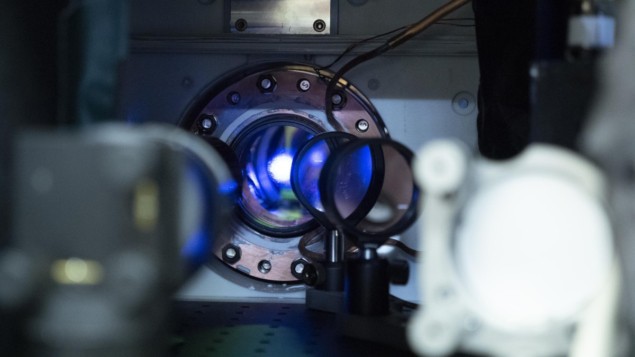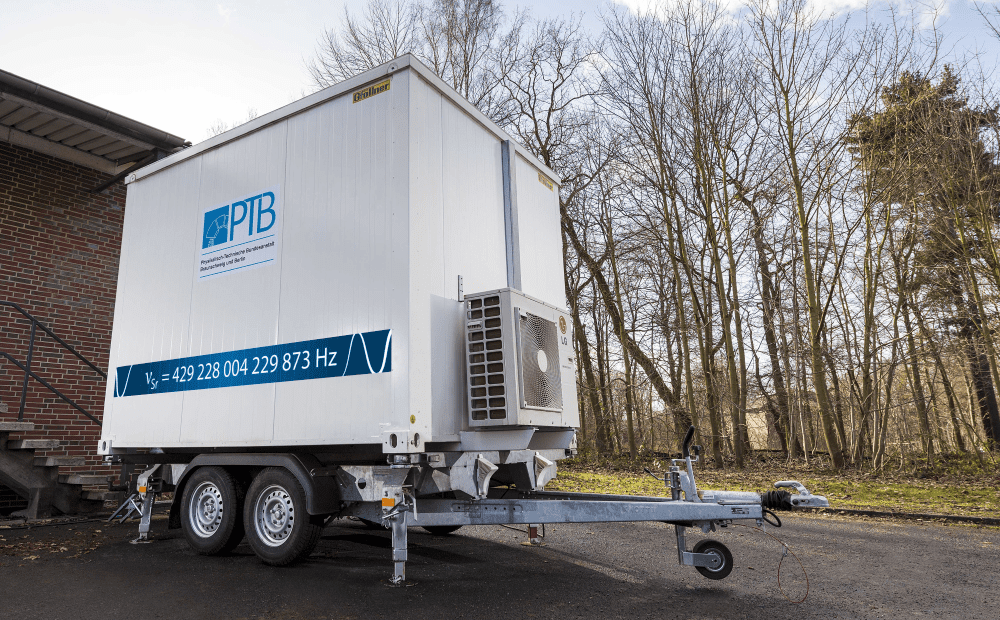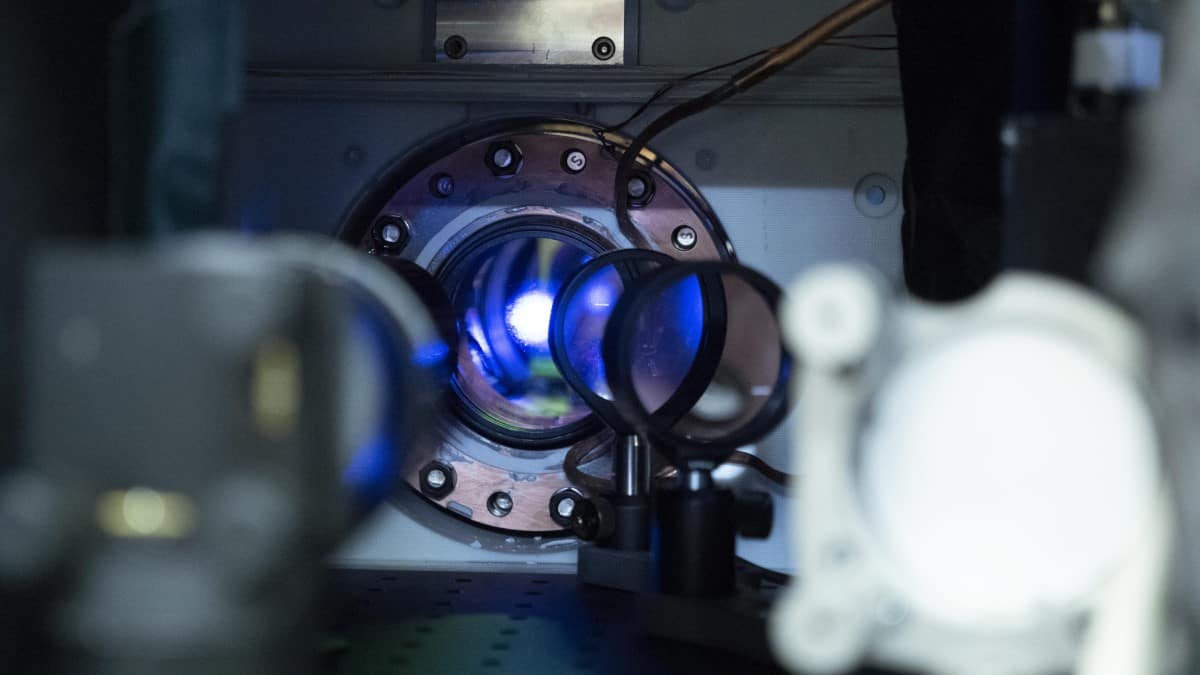
Two independent teams of researchers in the US have used differential measurement techniques to remove laser noise from atomic clocks, allowing them to observe tiny differences in how gravity affects atoms separated by a centimetre or less in height. One of the teams hopes that its practical technique could allow atomic clocks to be used more widely in applications such as geodesy and gravitational wave detection. The second group is the first to demonstrate that time runs slower at the bottom of a millimetre-sized atomic ensemble than it does at the top – further confirming a prediction of Einstein’s general theory of relativity.
Atomic clocks are the most precise timekeeping devices invented so far. They work by using the frequency of an extremely narrow transition in an atom or ion as a reference standard for the frequency of a laser. The best atomic clocks are so stable that they would be out by less than one second after running for the age of the universe.
This precision allows for astonishing experiments to be done. In 2018, for example, researchers at the US National Institute for Standards and Technology (NIST) in Boulder, Colorado compared the frequencies of two state-of-the-art clocks comprising ytterbium atoms trapped in optical lattices. This comparison was done at a precision of about 1 part in 1018, which is good enough to detect the tiny difference in the frequencies of two clocks when one clock is just 1 cm higher in elevation than the other.
Gravitational time dilation
This frequency difference occurs because the lower clock is slightly closer to the centre of the Earth and therefore experiences a slightly larger acceleration due to Earth’s gravity than the upper clock. This causes the lower clock to run slower than the upper clock – an effect called gravitational time dilation, which is predicted by general relativity.
The ability to make such measurements outside the lab could lead to “relativistic geodesy”, whereby atomic clocks provide extremely precise information about Earth’s shape, interior, and gravitational field. Other potential applications include gravitational wave detection, which could involve putting high-performance atomic clocks in space. However, today’s best atomic clocks are extraordinarily precise scientific instruments, and taking them outside the lab without sacrificing stability is not currently possible.
One team reporting new results is led by Shimon Kolkowitz of University of Wisconsin-Madison. It has taken an important step towards solving this stability problem by trapping two ensembles of strontium atoms at different elevations in the same vertical 1D optical lattice. The team addressed each ensemble with the same, commercially available laser. Both ensembles were subject to the same laser noise – which was relatively large compared to the state-of-the-art devices created at NIST.
Kolkowitz points out that “you can’t use [our system] as a traditional clock…We don’t learn about the absolute frequency, but we do know that it’s the same for both ensembles”.
Equally affected by noise
Crucially, tiny differences in the behaviors of the two ensembles could be measured because the laser noise affected both equally. The researchers achieved a relative uncertainty in their difference measurements of less than 1 part in 1019, which allowed them to observe gravitational time dilation.
Kolkowitz and colleagues went on to develop networks of clocks in their optical lattice comprising six ensembles of atoms. They were also able to use different isotopes of strontium in each ensemble. This could be useful in the search for deviations from the Standard Model of particle physics, explains Kolkowitz, “You’d really like to learn about the difference in the clock transition for two different isotopes of strontium”. He adds, “There are proposals for using those measurements to search for new particles and new forces,” and points out that Vladan Vuletic at the Massachusetts Institute of Technology has done measurements using different atoms.
Meanwhile, Jun Ye and colleagues at the Joint Astrophysical Laboratory (JILA) – operated by NIST and the University of Colorado – did a similar experiment using an existing strontium optical clock that is one of the most stable in the world. They were able to achieve a relative uncertainty of less than 1 part in 1020 when comparing strontium atoms within an optically-trapped ensemble that was just 1 mm in height. “We plotted a linear slope of the time dilation as a function of the vertical distance,” says Ye, which is predicted by general relativity.
Very high fidelity
“We still took advantage of laser noise being differentially removed,” explains Ye, “but the laser quality played an important role in our experiment in the sense that the state preparation was extremely clean and very high fidelity”.
The JILA team hopes to improve their technique even further so that they can study the effects of gravity on macroscopic quantum states. “I don’t think we’re at the scale of being able to talk about quantum gravity,” Ye says. “In quantum gravity, the concept of time itself becomes multi-dimensional and discontinuous. However, [future work] will probably bring general relativity to meet with the microscopic world and shed light on quantum decoherence by gravity.”

Portable optical lattice clock measures elevation
Both groups describe their research in separate papers in Nature.
“These are beautiful papers,” says atomic physicist Christian Lisdat of the German National Metrology Institute. “It’s really impressive to see how they use the capabilities we have to manipulate and to investigate atoms to circumvent some of the problems we are facing and to get better measurement capabilities.”
“I think they’re very, very nice advances along two different fronts,” say Vuletic. “Kolkowitz’s paper has this new technology to make multiple ensembles, which is very nice: it’s maybe less impressive along the axis of the development of accurate clocks but it’s more a field-opening paper. Ye’s paper is at the absolute precision frontier, and this ability to measure gravitational redshift over millimetres is just amazing.”
